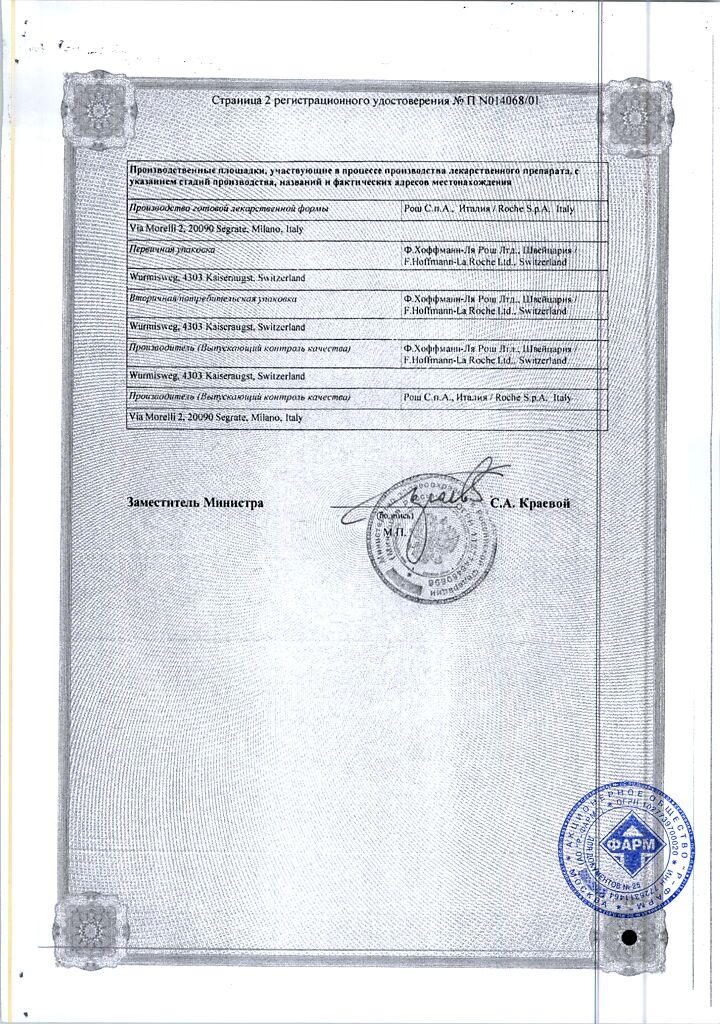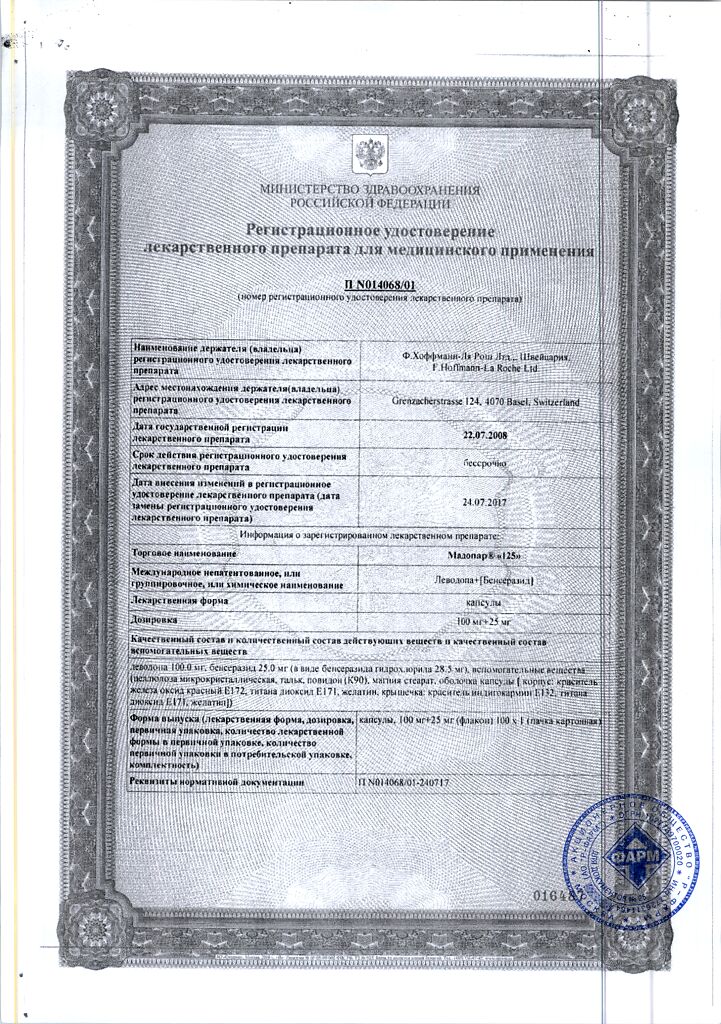No products in the cart.
Madopar, 125 mg capsules, 100 pcs.
€1.00
Out of stock
(E-mail when Stock is available)
Description
Madopar is a combined anti-Parkinsonian drug containing a dopamine precursor and a peripheral dopa decarboxylase inhibitor.
In parkinsonism, the brain neurotransmitter dopamine is produced in insufficient amounts in the basal ganglia. Replacement therapy is provided by prescribing levodopa, a direct metabolic precursor of dopamine, because the latter does not readily penetrate the BBB.
Levodopa is rapidly decarboxylated to dopamine in both cerebral and extracerebral tissues after oral administration. As a result, most of the levodopa administered does not reach the basal ganglia, and peripheral dopamine often causes side effects. Blocking extracerebral decarboxylation of levodopa is therefore highly desirable.
This is achieved by the simultaneous administration of levodopa and benserazide, a peripheral dopa decarboxylase inhibitor. Madopar is a 4:1 combination of these agents, which is optimal and has the same efficacy as levodopa at high doses.
The exact mechanism of restless legs syndrome is unknown, but the dopaminergic system plays an important role in the pathogenesis of this syndrome.
Indications
Indications
– Parkinsonism, including:
– In patients with dysphagia, with akinesia in the early morning and afternoon hours, patients with phenomena of “single-dose effect exhaustion” or “increased latency period” before the onset of clinical drug effect for those cases where a faster onset of action is required (predominantly Madopar fast acting tablets “125”).
– In patients with any type of levodopa action variation, namely “peak dose dyskinesia” and “single dose depletion” phenomenon, such as immobility at night (predominantly Madopar GSS “125” ).
Active ingredient
Active ingredient
Composition
Composition
1 capsule contains:
– Active ingredients
– Levodopa 100 mg.
– Benserazide 25 mg.
– Excipients
Microcrystalline cellulose,
Talc,
Povidone,
Magnesium stearate.
– The composition of the capsule cap Dye indigo carmine, titanium dioxide, gelatin.
– Composition of the capsule body Dye red iron oxide, titanium dioxide, gelatin.
How to take, the dosage
How to take, the dosage
The drug should be taken, if possible, at least 30 minutes before or 1 hour after meals.
The treatment should be started gradually, adjusting doses individually until optimal therapeutic effect is achieved. The following dosing guidelines should be considered as general guidelines.
Madopar “125” capsules should be swallowed whole without chewing.
– Standard dosing regimen
– Parkinsonism In the early stages of Parkinson’s disease, it is recommended to start treatment with Madopar at a dose containing 50 mg of levodopa + 12.5 mg of benserazide 3-4 times daily. If tolerated well, the dose should be gradually increased, depending on the patient’s response. Optimal effect is usually achieved with a daily dose of 300-800 mg levodopa + 75-200 mg benserazide, taken in 3 or more doses. It may take 4 to 6 weeks to achieve optimal effect. Further increases in the daily dose, if necessary, should be made at 1 month intervals. The average maintenance dose is 125 mg (100 mg levodopa + 25 mg benserazide) of Madopar 3-6 times daily. The frequency of administration (at least 3 times) during the day should be distributed so as to ensure optimal effect. To optimize the effect, it may be necessary to replace Madopar “125” in regular capsule form with Madopar fast-acting tablets (dispersible) “125” or Madopar GSS “125”.
– Restless legs syndrome The drug should be taken 1 h before bedtime, with a small amount of food. The maximum dose is 500 mg/day.
– Idiopathic restless legs syndrome with sleep disturbances Madopar “125” capsules are recommended. The initial dose is 62.5-125 mg, the maximum dose is 250 mg.
– Idiopathic restless legs syndrome with sleep disturbances The initial dose is 1 capsule of Madopar GSS “125” and 1 capsule of Madopar “125” 1 h before sleep. If the effect is insufficient, the dose of Madopar GSS “125” should be increased to 250 mg (2 capsules).
– Idiopathic restless legs syndrome with disturbances during the day The drug should be taken in a dose of 1 capsule of Madopar “125”, the maximum dose is 500 mg/day.
– Restless legs syndrome in patients with chronic renal failure receiving dialysis The drug should be taken in a dose of 125 mg (1 capsule of Madopar “125”) 30 min before dialysis.
The daily dose should not exceed the recommended maximum dose of 500 mg/day to rule out an increase in restless legs symptoms (early onset during the day, increased severity and involvement of other body parts). If clinical symptoms increase, the dose of levodopa should be reduced or levodopa should be gradually withdrawn and other therapy prescribed.
– In special cases, Madopar may be combined with other anti-Parkinsonian drugs. However, as treatment with Madopar continues and its therapeutic effects become apparent, it may be necessary to reduce the doses of other drugs or gradually withdraw them. If severe motor fluctuations (on-off phenomenon, single-dose exhaustion) are observed throughout the day, either more frequent and correspondingly smaller single doses are recommended or – preferably – the use of GSS “125” Madopar.
The clinical effect can be achieved more quickly by prescribing Madopar GSS “125” together with Madopar “125” capsules. This may be acceptable as a first morning dose, which should be slightly higher than subsequent doses. If Madopar GSS “125” is not effective enough even at the daily dose corresponding to 1500 mg of levodopa, it is recommended to return to the previously used treatment with Madopar “125”.
Spontaneous movements such as chorea or athetosis in the later stages of treatment can be eliminated or attenuated by reducing the dose. With long-term use, the occurrence of freezing episodes, waning effects toward the end of the dose period, and on-off phenomena can be eliminated or greatly reduced by reducing the dose or prescribing the drug at a lower dose but more frequently. Subsequently, you can try increasing the dose again to increase the effect of the treatment.
– Use in renal insufficiency In patients with mild to moderate renal insufficiency, no dose adjustment is required. Madopar is well tolerated by patients receiving hemodialysis sessions.
Interaction
Interaction
– Pharmacokinetic interaction Concomitant use of trihexyphenidyl (anticholinergic drug) with conventional dosage forms of Madopar (Madopar “125” capsules) decreases the rate but not the degree of absorption of levodopa. Ferrous sulfate decreases plasma C max and AUC of levodopa by 30-50%; these changes are clinically significant in some cases. Metoclopramide increases the rate of absorption of levodopa. Levodopa does not interact pharmacokinetically with bromocriptine , amantadine , selegiline and domperidone.
Pharmacodynamic interactions Neuroleptics, opioids and antihypertensive drugs containing reserpine inhibit the effects of Madopar. If it is necessary to prescribe Madopar to patients receiving non-reversible non-selective MAO inhibitors, at least 2 weeks should pass from the moment when the MAO inhibitor is discontinued until the beginning of Madopar administration.
Selective type B MAO inhibitors (including selegiline, rasagiline) and selective type A MAO inhibitors (moclobemide) may be prescribed against treatment with Madopar. At the same time it is recommended to adjust levodopa dose depending on individual patient’s need in terms of efficacy and tolerability.
The combination of MAO type A and MAO type B inhibitors is equivalent to taking a non-selective MAO inhibitor, so this combination should not be prescribed concomitantly with Madopar. Madopar should not be prescribed simultaneously with sympathomimetics (epinephrine, norepinephrine, isoproterenol, amphetamine), because levodopa may potentiate their action.
If simultaneous use is still necessary, the cardiovascular system should be monitored carefully and the dose of sympathomimetics should be reduced if necessary. It is possible to combine the drug with other antiparkinsonian agents (anticholinergic, amantadine, dopamine agonists), and in this case not only the desirable but also undesirable effects may increase. It may be necessary to reduce the dose of Madopar or another drug.
If Madopar is used concomitantly with a COMT inhibitor, it may be necessary to reduce the dose of Madopar. If treatment with Madopar is initiated, anticholinergic medications should not be abruptly withdrawn because levodopa does not take effect immediately. Because patients receiving Madopar may experience BP fluctuations and arrhythmias during halothane anesthesia, Madopar should be discontinued 12-48 hours before surgical intervention.
Levodopa may affect the results of laboratory determination of catecholamines, creatinine, uric acid and glucose, false positive Coombs test results are possible. In patients receiving Madopar, taking the drug concomitantly with protein-rich food may impair absorption of levodopa from the gastrointestinal tract.
Special Instructions
Special Instructions
Persons with hypersensitivity to the drug may have reactions.
Gastrointestinal side effects, which may occur in the initial phase of treatment, are largely eliminated if Madopar is taken with small amounts of food or liquids and if the dose is increased slowly.
Patients with open-angle glaucoma should have their intraocular pressure measured regularly because, in theory, levodopa may increase intraocular pressure.
Hypatic and renal function and blood counts should be monitored during treatment.
Patients with diabetes mellitus should frequently monitor blood glucose levels and adjust the dose of oral hypoglycemic medications.
If possible, administration of Madopar should be continued as long as possible before general anesthesia, with the exception of halothane anesthesia. Because patients receiving Madopar may experience BP fluctuations and arrhythmias during halothane anesthesia, Madopar should be discontinued 12-48 h before the surgical intervention. After surgery, treatment is resumed, gradually increasing the dose to the previous level.
Madopar should not be abruptly withdrawn. Abrupt withdrawal of the drug may lead to MNS (fever, muscle stiffness, and possible psychiatric changes and elevation of serum CPK), which may take a life-threatening form. If these symptoms occur, the patient should be monitored by a physician (hospitalization if necessary) and receive appropriate symptomatic therapy, which may include re-prescribing Madopar after appropriate evaluation of the patient’s condition.
Depression may be a clinical manifestation of an underlying illness (parkinsonism, restless legs syndrome) and may also occur with Madopar therapy. Patients taking Madopar should be closely monitored for possible psychiatric adverse reactions.
In some patients with parkinsonism, behavioral and cognitive impairment have been noted as a result of uncontrolled use of increasing doses of the drug despite physician recommendations and significant exceeding of the therapeutic doses of the drug.
– Use in liver dysfunction Contraindicated in decompensated liver dysfunction.
– Use in renal dysfunction Contraindicated in decompensated renal dysfunction.
– Effect on driving and operating machinery In case of drowsiness, sudden episodes of drowsiness, the patient should refrain from driving or operating machinery. If these symptoms occur, consideration should be given to reducing the dose or cancelling therapy.
Contraindications
Contraindications
– Decompensated disorders of the endocrine system.
– Decompensated liver.
– Decompensated renal disorders (except for patients with restless legs syndrome receiving dialysis).
– Decompensated dysfunction of cardiovascular system.
– Mental diseases with psychotic component.
– Closed-angle glaucoma.
– Concomitant administration with non-selective MAO inhibitors, combination of MAO type A and MAO type B inhibitors (which is equivalent to non-selective MAO inhibition).
– Age up to 25 years old (bone skeleton development must be completed).
– Women of childbearing age who do not use reliable methods of contraception.
– Pregnancy.
– Breast-feeding period.
– Hypersensitivity to the drug components.
Overdose
Overdose
– Symptoms: aggravation of side effects – arrhythmia, confusion, insomnia, nausea and vomiting, abnormal involuntary movements.
– Treatment: symptomatic therapy – respiratory analeptics, antiarrhythmic agents, neuroleptics; vital functions should be controlled.
Pregnancy use
Pregnancy use
Madopar is contraindicated in pregnancy and in women of childbearing age who do not use reliable methods of contraception.
If pregnancy occurs during treatment with Madopar, the drug should be stopped immediately.
It has been shown in experimental studies on animals that Madopar may cause abnormal skeletal development in the fetus.
It is not known whether benserazide is excreted with the breast milk. If it is necessary to use Madopar during lactation, breastfeeding should be stopped, because skeletal development disorders in the child cannot be excluded.
Additional information
| Shelf life | 3 years |
|---|---|
| Conditions of storage | At a temperature not exceeding 25 °C |
| Manufacturer | F. Hoffmann-La Roche Ltd, Switzerland |
| Medication form | capsules |
| Brand | F. Hoffmann-La Roche Ltd |
Related products
Buy Madopar, 125 mg capsules, 100 pcs. with delivery to USA, UK, Europe and over 120 other countries.



















